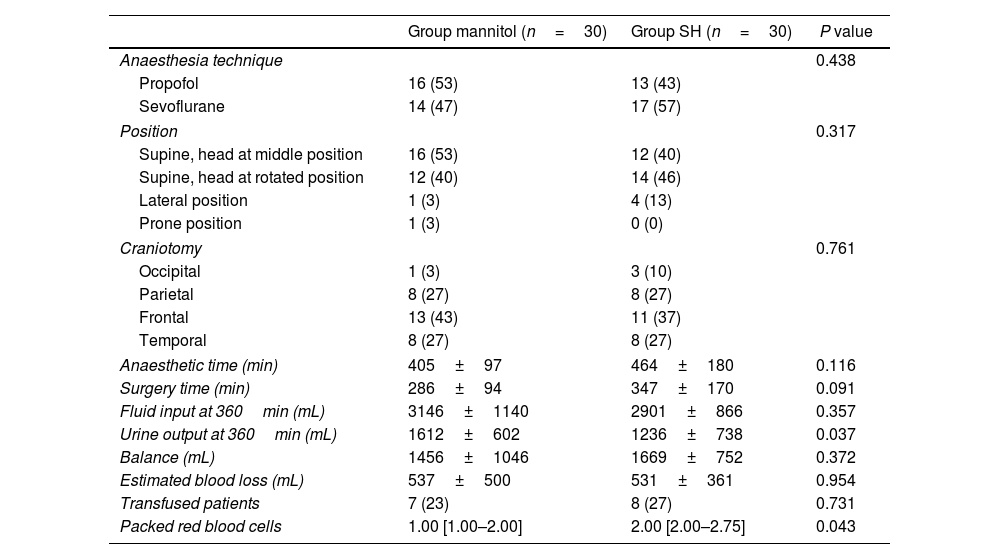A prospective, randomized, double-blind study was designed to assess differences in brain relaxation between 20% mannitol and 3% hypertonic saline (HS) during elective supratentorial brain tumour surgery in patients with midline shift.
Material and methodsSixty patients undergoing supratentorial craniotomy for tumour resection were enrolled to receive either 5mL/kg of 20% mannitol (n=30) or 3% HS (n=30) administered at skin incision. PCO2 in arterial blood was maintained within 35–40mmHg and arterial blood pressure was controlled within baseline values ±20%. The primary outcome was the proportion of satisfactory brain relaxation. The surgeon assessed brain relaxation on a four-point scale (1=excellent with no swelling, 2=minimal swelling, 3=serious swelling not requiring treatment, 4=severe swelling requiring treatment). Postsurgical intracranial changes determined by imaging techniques, postoperative complications, PACU and hospital stay, and mortality at 30 days were also recorded. Appropriate statistical tests were used for comparison; P<0.05 was considered as significant. This trial was registered in Eudract.ema.europa.eu (#2021-006290-40).
ResultsThere was no difference in brain relaxation: 2.00 [1.00–2.00] and 2.00 [1.75–3.00] for patients in mannitol and HS groups, respectively (P=0.804). Tumour size (OR: 0.99, 95% CI: 0.99–1.01; P=0.371), peritumoral oedema classification (OR: 0.57, 95% CI: 0.11–2.84; P=0.493), mass effect (OR: 0.86, 95% CI: 0.16–4.87; P=0.864), anaesthesia (OR: 4.88, 95% CI: 0.82–28.96; P=0.081) and midline shift (OR: 5.00, 95% CI: 0.84–29.70; P=0.077) did not have a significant influence on brain swelling in patients treated with either mannitol or HS. No significant differences in perioperative outcomes, mortality and length of PACU and hospital stay were observed.
Conclusions5mL/kg of 20% mannitol or 3% HS result in similar brain relaxation scores in patients undergoing craniotomy for supratentorial brain tumour with midline shift.
Estudio prospectivo, aleatorizado y doble ciego diseñado para evaluar diferencias en la relajación cerebral entre manitol 20% y salino hipertónico (SH) 3% durante cirugía supratentorial electiva por tumor cerebral en pacientes con desviación de línea media.
Material y métodosSesenta pacientes sometidos a craneotomía supratentorial para resección tumoral se estudiaron para recibir 5ml/kg de manitol 20% (n=30) o SH 3% (n=30) administrados durante la incisión cutánea. La pCO2 en sangre arterial se mantuvo entre 35-40mmHg y la presión arterial se controló dentro de valores basales±20%. El objetivo principal fue la proporción de relajación cerebral satisfactoria. El cirujano evaluó la relajación cerebral en una escala de 4 puntos (1=excelente sin hinchazón, 2=hinchazón mínima, 3=hinchazón grave que no requiere tratamiento, 4=hinchazón severa que requiere tratamiento). Los cambios intracraneales posquirúrgicos determinados por técnicas de imagen, complicaciones postoperatorias, estancia en reanimación y hospitalaria, así como mortalidad a 30 días fueron registrados. Se usaron test estadísticos para la comparación, siendo considerado p<0,05 como significativo. El ensayo fue registrado en Eudract.ema.europa.eu (#2021-006290-40).
ResultadosNo hubo diferencias en la relajación cerebral: 2,00 [1,00-2,00] y 2,00 [1,75-3,00] en los pacientes del grupo manitol y SH respectivamente (p=0,804). El tamaño tumoral (OR: 0,99: IC 95%:0,99-1,01; p=0,371), nivel de edema peritumoral (OR: 0,57; IC 95%:0,11-2,84; p=0,493), efecto masa (OR: 0,86; IC 95%: 0,16-4,87; p=0,864), anestesia empleada (OR: 4,88; 95% IC: 0,82-28,96; p=0,081) y desviación de la línea media (OR: 5,00; IC 95%: 0,84-29,70; p=0,077) no tuvieron influencia significativa sobre la hinchazón cerebral en los pacientes de ambos grupos. No hubo diferencias significativas en los resultados perioperatorios, mortalidad ni en estancia en reanimación ni hospitalaria.
ConclusionesTanto manitol 20% como SH 3% a 5ml/kg consiguen niveles similares de relajación cerebral en pacientes sometidos a craneotomía para tumor cerebral supratentorial con desviación de la línea media.
Artículo

Si es la primera vez que accede a la web puede obtener sus claves de acceso poniéndose en contacto con Elsevier España en suscripciones@elsevier.com o a través de su teléfono de Atención al Cliente 902 88 87 40 si llama desde territorio español o del +34 932 418 800 (de 9 a 18h., GMT + 1) si lo hace desde el extranjero.
Si ya tiene sus datos de acceso, clique aquí.
Si olvidó su clave de acceso puede recuperarla clicando aquí y seleccionando la opción "He olvidado mi contraseña".














